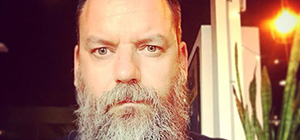Let us talk about stroke by Associate Professor Bruce Campbell
Artist Bob Carey-Grieve, 43, recently clocked up one year since stroke turned his world upside down. The stroke didn’t leave an impact physically, but mentally it has left a lasting imprint – with the fear it could happen again and could be worse next time. It put enormous stress on Bob and, in turn, on those who loved him most.
Bob reflected on the first anniversary of his stroke with an honest and raw blog, published on the Stroke Foundation’s Facebook page. Something interesting happened afterwards. Men started to comment. Not just one or two, but men got involved in the conversation – many offering words of support and detailing their own accounts of stroke.
The volume of men who connected with Bob was above that of a normal post on the page.
It was encouraging to see this reaction because men are traditionally not as open as women when it comes to health. Issues like this won’t go away by ignoring them.
In 2018, 56,000 Australians will suffer a stroke – that is one every nine minutes. It will kill more men that prostate cancer and more women than breast cancer.
As evident by Bob’s stroke, this devastating disease can strike people of all ages. Alarmingly, around 30 percent of strokes happen to Australians of a working age who have their whole lives ahead of them.
Stroke can change lives in an instant. Many survivors have to re-learn how to walk or talk or perform the simplest daily activities like eating, dressing and bathing.
While there have been major advances in time-critical treatment for stroke and it is no longer a death sentence, it is one of the main causes of disability in Australia.
However, this does not have to be a story with a gloomy outlook. Encouragingly, up to 80 percent of strokes are preventable. You just need the knowledge and the tools to do so.
High blood pressure is a key risk factor for stroke and one that can be managed. 4.1 million Australians have high blood pressure and many of us don’t realise it.
Having high blood pressure doesn’t make you feel any different – you have to have it measured it to know. It is more common in men than women (24 percent to 20 percent). Research has shown the number of strokes would be practically cut in half (48 percent) if high blood pressure alone was eliminated.
Other risk factors include atrial fibrillation (an irregular heart beat), inactivity, carrying too much weight, smoking, high cholesterol, diabetes and a high intake of alcohol. These can all be managed by seeing your General Practitioner (GP) and adopting a healthy lifestyle.
When someone suffers a stroke, every minute counts. Brain cells die at a rate of up to 1.9 million a minute. The faster treatment is sought, the better the chance of recovery.
I urge you to visit a GP and understand your own stroke risk. Don’t assume it will never happen to you. Between the ages of 55 and 84, men are far more likely to have a stroke than women.
It is also important to know how to recognise the signs of a stroke. This information could save a life of a family member, a mate – or possibly even your own life.
By Stroke Foundation Clinical Council Chair Associate Professor Bruce Campbell

